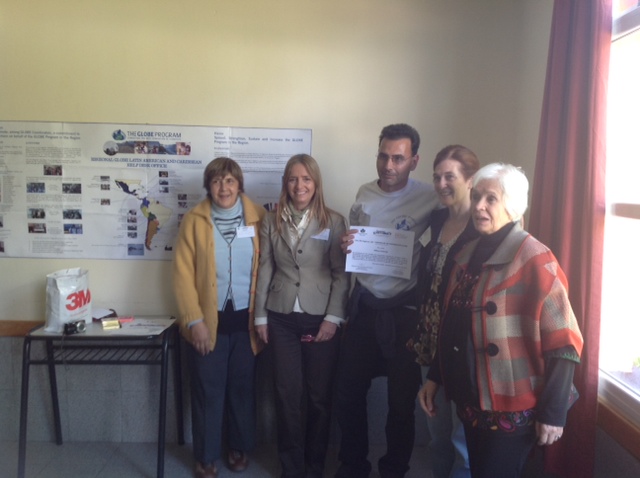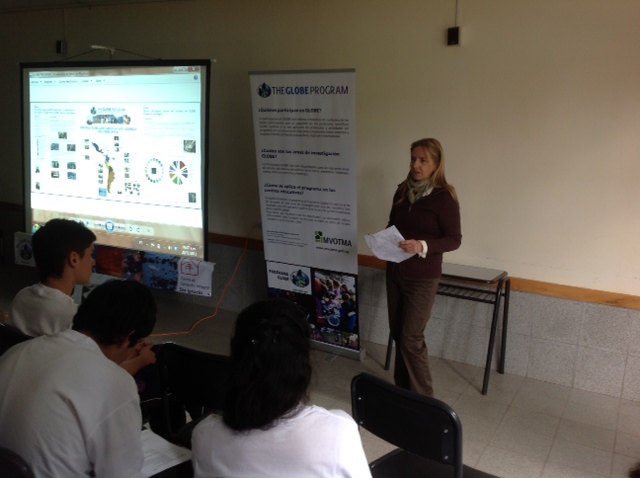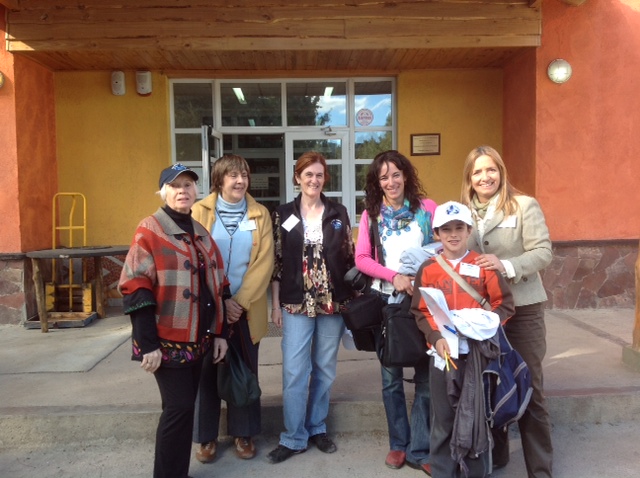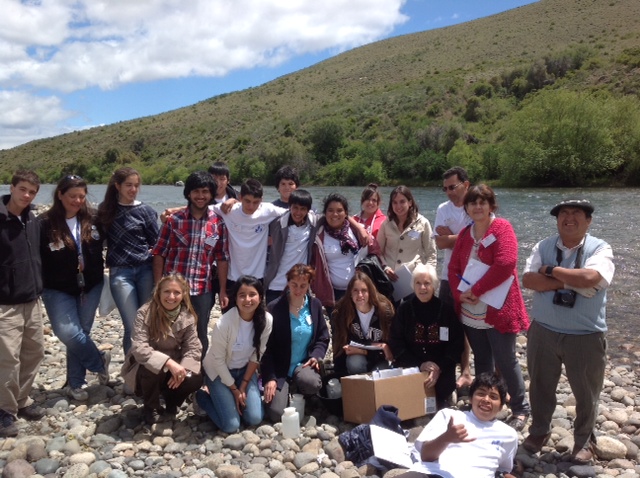Stars and STEM Stories
Developing Awareness about El Niño and La Niña Phenomena on Land Cover

From 30 November to 1 December 2012, a Latin America and Caribbean Regional Workshop and Trainer of Trainer event took place in CEI "San Ignacio" in the Valley of San Cabao, located 10 km from Junin de los Andes, Neuquen Province, Argentina. This important event included GLOBE community members from Argentina, Uruguay and Peru and aimed to train more teachers and students in GLOBE hydrology, atmosphere and land cover protocols. GLOBE Master Trainer Patricia Piriz from Uruguay, along with Master Trainers Ana Prieto, Marta Kingsland, and Marta Beatriz Vasquez from Argentina. María Marta Daneri, also from Argentina assisted with the agenda. Teachers and students from the CEI "San Ignacio," María Auxiliadora Institute, Escuela Primaria No. 344, Cento Provincial de Enseñanza Media No. 7 and the Supervisora de Escuelas Rurales of Comallo area of the Río Negro Province attended the workshop. "The participation of the students from María Auxiliadora Institute and Escuela Primaria No. 344 together with their teacher María de los Ángeles Mora was remarkable," stated Ana Prieto.
The joint project includes opportunities to promote ongoing work between countries involved through face-to-face interactions using online resources such as videoconferencing for meetings and other ICT tools. In addition, student projects will incorporate satellite images and data analyses during the years in which "El Niño" or "La Niña" had a strong impact on the participant countries, in order to analyze the effects of these events on the prairies and forests biomes in Peru, Argentina and Uruguay.Additionally architect Maria del Carmen Simone Galloni de Grimaux and Mrs. Amalia Aubone, from the GLOBE Latin America and Caribbean Regional Help Desk Office, participated in the collaborative effort to develop a research framework designed to analyze and understand the effects of the El Niño and La Niña phenomena on land cover in three different countries and study sites.

The research plan not only includes different countries, but also incorporates different levels of education (primary, secondary and university). This involves constant coordination and a large commitment from the participating teachers and students. Biologist Vasco M. Mantas, an expert in the interpretation of satellite images from the University of Coimbra in Portugal, joined the team to further support students and teachers in the process of scientific interpretation of the images to be used to achieve the objectives of this project. Additionally, the project has the support of the National University of Comahue in Argentina, represented by Dr. Ricardo Chrobak, Director of Project Learning to Teach Physics and the Environmental Education Research Group where Master Trainer Ana Prieto belongs.
Highlights from the different teams involved in this collaborative project are below.
Uruguay: Teacher Patricia Píriz with the Science Club "Benthic" of Montevideo. Milton Camejo and students Melisa Kitts and Claudio Lacuesta.
Argentina: Teacher María Inés Amato with the School Marín de Beccar, Bs. As. with students: Matías Casares, María Agustina Girona Acevedo, Agustín Grunauer, María Lohlé, Joaquín Mirabelli and María Eugenia Negri.
Argentina: Teachers Ana Prieto and María Eugenia Bertossi with the Agrotechnical High School CEI "San Ignacio" from Junín de los Andes. Students: Nicolás Amaranto Manqui, Martina Joubert, Carlos Llaytuqueo, Deborah Melo, Joaquín Porma, Rocío Porma Favre, Marilina Porma Favre, Gabriel Riffo, Diego Valeria, Jeremías Porma Favre, Lucrecia Colligual, Javier Riffo, Luis Prieto, Jeremías Hermosilla and Cristian Flores.
Perú: Teacher Claudia Caro Vera from National Agraria University La Molina from Lima with her students studying Meteorology, Environmental Engineering and Biology: Renzo Samaniego, Luis Andrés Rodríguez, Dante Castro, José Carlos Rivas, Rogelio Campos, Gustavo De la Cruz, Jonathan Paredes, Aldo Alessi, Jean Franco Tineo, Raquel Mori and Juan Diego Calvo –Pérez (GLOBE Alumni Regional Representative from the Latin American and Caribbean Region), who connected to the event taking place in Argentina through an inspiringvideoconference.

The student commitment and dedication to their project can heard through their testimonies below:
Lautaro Porma Favre (GLOBE Alumni from CEI "San Ignacio"), Argentina
"When I entered school I was 12 years old and now I am 19. After 7 years of the GLOBE in my life, time that I spent taking GLOBE measurements, the experience completely changed my understanding of what science and scientific research is. Through GLOBE, we learn that there is much more to science then just working in a super-sophisticated scientific laboratory, to do the things that we do to gather data and the research that we did when I was a student. GLOBE, I think helps a lot of that. The experience we gained last year at the Conference on Climate Change of UBA was very good experience because I saw they were all boys and teachers from University and we high school kids. People were super-experienced and congratulating us for our work. Also when I had the chance to go to Panama to represent my country at a meeting of TUNZA, I told them about the things we did here, describing our GLOBE research, and they were all amazed because high school kids who do things like this are not common, and much less implemented through international protocols that the GLOBE program has.
If you have the opportunity to work on all the things involved in the GLOBE program, please do it! It is not only about taking data, it is also about to accomplish great things that can help you to change the way you see things."
Diego Valeria (student from CEI "San Ignacio"). Argentina
""When I started with GLOBE in school, I was interested in all measurements because I always liked environmental issues. Participating in the GLOBE Program was important. I would like to leave something someday, and that our work will make a difference to people and so they can see what will happen in the future because I think that people in the world were not thinking about what was going on before, we were unaware. GLOBE is very important to me and I like the way it works in general, it gives support to the research projects you have in mind, and helps you."
Rocío Porma Favre (alumna del CEI "San Ignacio"), Argentina
"The GLOBE Program is good because if you think I take one minute, one second of my life to measure the water, in order to do something about the Earth and that is all... this is not only for you but also for everyone in the future. You know that with other people you are going to help, even if only a little bit, to change the world, by what we are producing, because the mentality of consumerism that all humans have, makes up the world we live in. With just going out and measuring the water we are helping ourselves, becoming aware of our surroundings and helping others to become aware"

Joaquín Mirabelli (student of Colegio Marín School), Argentina
"It was very good. For us it was the first time we traveled to Argentina and we had no idea about what was waiting for us, and it was surprising that people from different regions could think together in one day and be able to gather information and organize research. In the evening meeting we were busy to plan the project for the next day and half hour after we started we were already doing things. Things were better than we expected. I did not have any idea about this work but learned with the help of Ana and Patricia who have a lot of knowledge and who share their experiences with us. I have learned a lot. I liked it a lot."
Matías Casares (student from Colegio Marín), Argentina
"I believe that joining several regions and countries to work together is an important cultural exchange. We had never even made a field investigation in San Isidro before. Coming here and seeing it in an Agrotechnical School was great. "
Agustín Grunauer (student of Marín School), Argentina
"In this case it also helped being with people from other regions who were practicing the same things and feeling that if we not know something, we could ask our friends without asking teachers all the time…..and in this way we helped each other."
Claudio Lacuesta, Uruguay
"We learned and taught each other the GLOBE protocols working in groups with students from other regions. It felt like a new lunderstanding, a new experience. The best was watching nature, snow, volcanic landscape. I will not forget what we learned, the new friendships, the new experiences and everything we observed. "
Melisa Cristóbal, Uruguay
"I think that the fact of working together with other countries is a great opportunity to see how other people work, how they live, and how they are personally. You see other realities. We plan to continue this work together, to keep getting together in different places and to see what changes occur to advance the research.
To the GLOBE authorities, I will tell them that what they do is terrific, it is a unique opportunity that we had. The act of going to other places, meeting new people. that is what makes GLOBE awesome."
Rogelio Campos: Student of Environmental Engineering of National Agrarian University La Molina, Peru
"In my opinion, I think this work is very inclusive, and important to obtain awareness, because it includes students of primary, secondary and university levels as well as teachers and scientists. Thats exactly what you should do to be aware of the effects of the climate change, beginning when you are young and to the adults. Something that stands out with this work is the use of satellite images, which is something not widely known, but in this project there is great importance on interpretation of the impact El Niño and La Niña could have on climate change."
Juan Diego Calvo-Pérez: Biology student of the National Agrarian University La Molina, Peru
The work that we are doing with Argentina, Uruguay and Peru is an excellent GLOBE opportunity to link Latin American countries in a new experience that opens new doors and creates new expectations for the future of our region."
Gustavo De la Cruz Montalvo: Meteorology Student of The National Agrarian University La Molina, Peru
"I am excited to participate in this project because I have the opportunity to meet students from other countries working with GLOBE, and also because I am very interested in working with Junín National Reserve in Peru as a thesis topic for my meteorologist title next year "
Renzo Samaniego: Meteorology Student of The National Agrarian University La Molina, Peru
The Junin de los Andes workshop was great because we were able to share knowledge and meet more people. It should be noted that it was also important because it allowed us to resolve some concerns about land cover related to ENSO, a good topic to study because we can get better understanding about its effect on the different countries involved in the study."
Presentation of Participation Certificates in Lanin National Park
For more information about this GLOBE workshop see:
https://sites.google.com/site/tallerglobepatagonia/home
Photo Gallery: https://sites.google.com/site/tallerglobepatagonia/galeria-de-fotos
Media material: http://www.rionegro.com.ar/diario/estudian-los-efectos-de-el-nino-y-la-nina-1018173-9546-nota.aspx
22 December 2012





